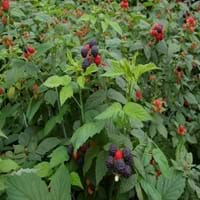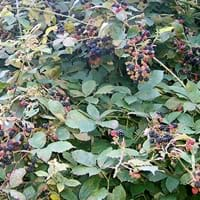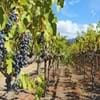Life Span
Perennial
Perennial
Origin
Hybrid origin
Hybrid origin
Types
Rubus leucodermis, Rubus occidentalis, Rubus coreanus
Not Available
Habitat
Cold Regions
ditches, vacant lots, wastelands
USDA Hardiness Zone
5-8
6-9
Sunset Zone
Not Available
1a, 1b, 2a, 2b, 3a, 3b, 4, 5, 6, 7, 8, 9, 10, 11, 12, 13, 14, 15, 16, 17, 18, 19, 20, 21, 22, 23, 24
Habit
Arching/Fountain-shaped
Upright/Erect
Flower Color Modifier
Bicolor
Bicolor
Leaf Color in Spring
Green
Green
Leaf Color in Summer
Green
Green
Leaf Color in Fall
Green
Green
Leaf Color in Winter
Light Green
Light Green
Plant Season
Summer
Summer
Sunlight
Full Sun
Full Sun
Type of Soil
Loam, Sand
Loam
The pH of Soil
Acidic, Neutral
Acidic, Neutral
Soil Drainage
Well drained
Well drained
Bloom Time
Early Spring, Spring
Spring
Tolerances
Drought
Drought
Where to Plant?
Ground
Ground
How to Plant?
Cuttings, Root Division
Stem Cutting
Plant Maintenance
Medium
Medium
Watering Requirements
Medium
Water frequently while growing
In Summer
Lots of watering
Lots of watering
In Spring
Moderate
Moderate
In Winter
Average Water
Average Water
Soil pH
Acidic, Neutral
Acidic, Neutral
Soil Type
Loam, Sand
Loam
Soil Drainage Capacity
Well drained
Well drained
Sun Exposure
Full Sun
Full Sun
Pruning
Prune in fall, Remove damaged leaves, Remove dead branches, Remove dead leaves, Remove dead or diseased plant parts
Remove damaged leaves, Remove dead branches, Remove dead leaves
Fertilizers
All-Purpose Liquid Fertilizer, Apply 10-10-10 amount
10-10-10 diluted liquid fertilizer
Pests and Diseases
Red blotch
Anthracnose, Aphids, bees, Birds, Caterpillars, Lily Beetle, Red blotch
Plant Tolerance
Drought
Drought, Variety of soil types
Flower Petal Number
Single
Single
Foliage Texture
Medium
Medium
Foliage Sheen
Matte
Matte
Attracts
Birds, Butterflies
Birds, Butterflies, Deers
Allergy
cramps, Diarrhea, Itchiness, Runny nose, Skin rash, sneezing, Swollen Lips, Tingly mouth, Vomiting, Watery eyes
Food Allergy, Runny nose, Sinuses, sneezing
Aesthetic Uses
Not Used For Aesthetic Purpose
Not Used For Aesthetic Purpose
Beauty Benefits
Good for skin
Not Available
Environmental Uses
Air purification, Food for birds, Food for insects, Nesting sites for birds, Shadow Tree, Windbreak
Air purification, Food for animals, Food for birds, Food for insects
Medicinal Uses
anti-cancer, Astringent, Diuretic, Febrifuge, Stomachic, Tonic
Fiber, Vitamin A, Vitamin C
Part of Plant Used
Bark, Fruits, Leaves
Fruits, Leaves, Seeds
Other Uses
Used As Food
Food for animals, Food for insects, Used as a nutritious food item, Used for its medicinal properties
Used As Indoor Plant
No
No
Used As Outdoor Plant
Yes
Yes
Garden Design
Edible, Fruit / Fruit Tree
Edible, Fruit / Fruit Tree, Hedges
Botanical Name
RUBUS 'Jewel'
RUBUS 'Apache'
Common Name
Black Raspberry
Blackberry
In Hindi
Black Raspberry Tree
ब्लैकबेरी
In German
Schwarze Himbeere Baum
Brombeere
In French
Noir Arbre Framboise
la mûre
In Spanish
Negro del árbol de la frambuesa
Mora
In Greek
Μαύρο Raspberry Δέντρο
Βατόμουρο
In Portuguese
Árvore framboesa Preto
Amora preta
In Polish
Czarny Raspberry Drzewo
Jeżyna
In Latin
Niger IDAEUS ligno
Etiam
Phylum
Magnoliophyta
Magnoliophyta
Class
Magnoliopsida
Magnoliopsida
Clade
Angiosperms, Eudicots, Rosids
Angiosperms, Eudicots, Rosids
Tribe
Not Available
Rubeae
Subfamily
Rosoideae
Rosoideae
Number of Species
Not Available
Properties of Black Raspberry and Blackberry
Wondering what are the properties of Black Raspberry and Blackberry? We provide you with everything About Black Raspberry and Blackberry. Black Raspberry has thorns and Blackberry doesn't have thorns. Also Black Raspberry does not have fragrant flowers. Black Raspberry has allergic reactions like cramps, Diarrhea, Itchiness, Runny nose, Skin rash, sneezing, Swollen Lips, Tingly mouth, Vomiting and Watery eyes and Blackberry has allergic reactions like cramps, Diarrhea, Itchiness, Runny nose, Skin rash, sneezing, Swollen Lips, Tingly mouth, Vomiting and Watery eyes. Compare all the properties and characteristics of these two plants. Find out which of these plant can be used as indoor plant. If you are interested to decorate your house and garden, find out aesthetic uses, compare them and select the plant which will beautify your surrounding. Along with beautification, try comparing medicinal and edible uses of Black Raspberry and Blackberry and you can choose the plant having best and most benefits.
Season and Care of Black Raspberry and Blackberry
Season and care of Black Raspberry and Blackberry is important to know. While considering everything about Black Raspberry and Blackberry Care, growing season is an essential factor. Black Raspberry season is Summer and Blackberry season is Summer. The type of soil for Black Raspberry is Loam, Sand and for Blackberry is Loam while the PH of soil for Black Raspberry is Acidic, Neutral and for Blackberry is Acidic, Neutral.
Black Raspberry and Blackberry Physical Information
Black Raspberry and Blackberry physical information is very important for comparison. Black Raspberry height is 182.88 cm and width 30.48 cm whereas Blackberry height is 150.00 cm and width 120.00 cm. The color specification of Black Raspberry and Blackberry are as follows:
Black Raspberry flower color: White
Black Raspberry leaf color: Green
Blackberry flower color: White
- Blackberry leaf color: Green
Care of Black Raspberry and Blackberry
Care of Black Raspberry and Blackberry include pruning, fertilizers, watering etc. Black Raspberry pruning is done Prune in fall, Remove damaged leaves, Remove dead branches, Remove dead leaves and Remove dead or diseased plant parts and Blackberry pruning is done Remove damaged leaves, Remove dead branches and Remove dead leaves. In summer Black Raspberry needs Lots of watering and in winter, it needs Average Water. Whereas, in summer Blackberry needs Lots of watering and in winter, it needs Average Water.





